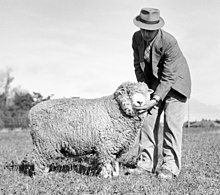
The Merino is a breed or group of breeds of domestic sheep, characterised by very fine soft wool. It was established in Spain near the end of the Middle Ages, and was for several centuries kept as a strict Spanish monopoly; exports of the breed were not allowed, and those who tried risked the death penalty. During the eighteenth century, flocks were sent to the courts of a number of European countries, including France, Hungary, the Netherlands, Prussia, Saxony and Sweden. The Merino subsequently spread to many parts of the world, including South Africa, Australia, and New Zealand. Numerous recognised breeds, strains and variants have developed from the original type; these include, among others, the American Merino and Delaine Merino in the Americas, the Australian Merino, Booroola Merino and Peppin Merino in Oceania, and the Gentile di Puglia, Merinolandschaf and Rambouillet in Europe.
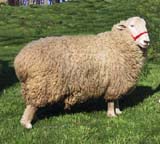
The Coopworth is a modern New Zealand breed of sheep. It was developed by researchers at Lincoln College in the Canterbury region of the South Island between about 1956 and 1968, the result of cross-breeding of New Zealand Romney ewes and Border Leicester rams. It has become the second-most numerous sheep breed in New Zealand, and has been exported to Australia, some European countries, and the United States.
The Perendale is a breed of sheep developed in New Zealand by Massey Agricultural College for use in steep hill situations. The breed is named after Sir Geoffrey Peren, and it achieves its aims by being the offspring of Romney ewes and Cheviot rams with sturdy legs. It is raised primarily for meat.
Polwarth is a breed of sheep that was developed in Victoria (Australia) during 1880. They were of one-quarter Lincoln and three-quarters Merino bloodlines. They are large, predominantly polled sheep with long, soft, quite fine wool and produce good meat carcasses. They were developed in an attempt to extend the grazing territory of sheep because the Merino was found lacking in hardiness in this respect. A dual-purpose breed with a major emphasis on wool production. Richard Dennis, of Tarndwarncoort in south west Victoria, bred the Polwarth, first known as Dennis Comebacks. Descendants of Richards Dennis continue to grow Polwarth wool at Tarndwarncoort, maintaining the original bloodlines in a flock referred to as the "Blue Dots".

The Cotswold is a British breed of domestic sheep. It originates in, and is named for, the Cotswold hills of the southern midlands of England. It is a large long-woollen sheep, and is kept as a dual-purpose breed, providing both meat and wool.

The Border Leicester is a British breed of sheep. It is a polled, long-wool sheep and is considered a dual-purpose breed as it is reared both for meat and for wool. The sheep are large but docile. They have been exported to other sheep-producing regions, including Australia and the United States.

The Romney, formerly called the Romney Marsh sheep but generally referred to by the local farmers as the Kent, is a breed of sheep originating in England. The Romney is a "long-wool" breed recognized in England by 1800. Exported to other continents, the Romney is an economically important sheep breed, especially to the sheep-meat and wool export trades of New Zealand.

The Dorset Horn is an endangered British breed of domestic sheep. It is documented from the seventeenth century, and is highly prolific, sometimes producing two lambing seasons per year. Among British sheep, it is the only breed capable of breeding throughout the winter.

The Cormo is an Australian breed of sheep developed in Tasmania by crossing Corriedale rams with superfine Saxon Merino ewes in the early 1960s. The name Cormo is derived from the names of two of the parent breeds, Corriedale and Merino. The breed was fixed through intense selection criteria, assessed by objective measurement. Cormo sheep have a polled, open face, are possessed of a fast-growing, medium frame carrying a fleece of about 18 to 23 microns in diameter. High fertility is an attribute, too.
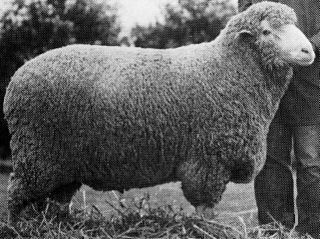
Bond sheep are an Australian sheep breed that was developed around 1909 near Lockhart, New South Wales by Thomas Bond when he mated Saxon-Peppin Merino ewes to stud Lincoln rams for primarily wool production. The resulting progeny was selected on the basis that they would be more suited to the Riverina environment. Initially these sheep were known as ‘the Commercial Corriedale’.
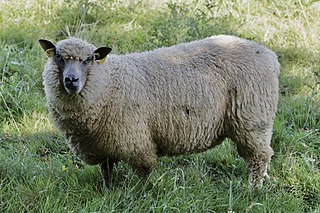
The Bleu du Maine is a French breed of domestic sheep. It originated in the historic region of Maine, and is distributed mainly in the départements of Maine-et-Loire, the Mayenne and the Sarthe in the Pays de la Loire in western France.
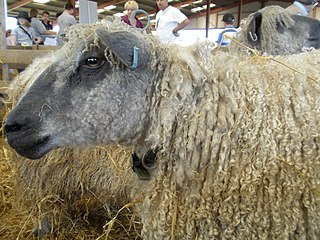
The Wensleydale is a British breed of domestic sheep. It is named for the Wensleydale region of North Yorkshire, in the north of England, where it was bred in the early nineteenth century by cross-breeding a Dishley Leicester ram with local long-woolled sheep of a breed that is now extinct. It has a blue-grey face and long purled wool, and is among the heaviest of British sheep breeds. It is an endangered breed, and is categorised as "at risk" by the Rare Breeds Survival Trust. It is often used as a ram breed to cross with other breeds to obtain market lambs, and for its high-quality wool.

The Galway is a breed of domestic sheep originating in Galway, in the west of Ireland. They are a large polled white-faced sheep, having a characteristic bob of wool on the head and wool on the legs. The outer lips are of a dark colour and dark spots on the ears are common. The average litter size is 1.45 in pedigree flocks. While a major proportion of ewes within the bred weigh 80–85 kg and have a litter size of 1.3, there is wide variation to be found.
The Devon Closewool is a British breed of domestic sheep. It is distributed almost exclusively on Exmoor in North Devon, in south-west England. It is raised primarily for meat.
The British Milksheep is a robust, dual-purpose sheep commonly known for its milking characteristics.

The Charmoise is a French breed of domestic sheep. It was created in the early nineteenth century by Édouard Malingié, by cross-breeding of Romney stock imported from the United Kingdom with local breeds including the Berrichon du Cher, Merino, Solognote and Tourangelle. It is reared for both meat and wool. Breed numbers fell from a peak of approximately 650000 in the 1960s to about 122000 in 1983, to approximately 21000 in 2001, and further to 8100 in 2014.
The Comeback is a type of domestic sheep originating in Australia. This type of sheep results from crossbreds produced by British Longwool sheep and Merinos being mated back to Merinos. This cross is made to achieve a finer, better style of wool. Comeback style wool is also produced by Bond, Cormo and Polwarth sheep and they may prove easier to breed than Comebacks. The Comeback sheep are raised for meat and their fine wool.

Sheep farming is a significant industry in New Zealand. According to 2007 figures reported by the Food and Agriculture Organization (FAO) of the United Nations, there are 39 million sheep in the country. The country has the highest density of sheep per unit area in the world. For 130 years, sheep farming was the country's most important agricultural industry, but it was overtaken by dairy farming in 1987. Sheep numbers peaked in New Zealand in 1982 to 70 million and then dropped to about 27.6 million. There are 16,000 sheep and beef farms in the country which has made the country the world's largest exporter of lambs, with 24 million finished lambs recorded every year.

The German Whiteheaded Mutton is a breed of sheep developed to live along the North Sea coast of Germany. It is a dual-use breed used for both its fine wool and meat production. They often graze along the North Sea dikes in Northern Europe.

The New Zealand Romney is a New Zealand breed of sheep. It derives from British Romney Marsh stock imported to New Zealand in the nineteenth century, and was established as a separate breed in 1904. It is the most numerous sheep breed in New Zealand.
